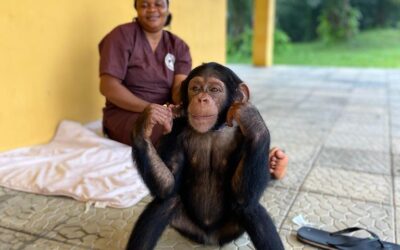to Great Apes and Monkeys
While the term “bushmeat” can simply stand for any wild animal killed for the purpose of eating its meat, most often in media it is used to refer to the illegal hunting of endangered, protected animals in Africa. The meat is either eaten by the hunter or sold to earn much-needed income. Ultimately, it is one of the few resources people in impoverished countries can use to meet basic protein requirements.
However, there are many factors that determine which species have the most pressure put on them and they can vary significantly by region. In countries of West Africa as well as in the Congo basin, bushmeat is now the leading threat to great apes, along with monkeys, elephants, antelope and almost any species that hunters opportunistically find in their forests.

Spanning across six countries in central Africa is the world’s second-largest tropical rainforest, the Congo Basin. From within the Congo basin alone, 6 million tons of bushmeat is taken from the forests each year. There is no easy solution to this, as keeping livestock here is not common. Additionally, trying to replace this amount of meat with livestock such as cattle would bring with it a new type of environmental disaster, including major deforestation and large amounts of waste products.

An additional factor in the culture of bushmeat is availability and taste preference. For example, in major cities in DRC and Central African Republic, bushmeat is viewed as a cheap form of protein and readily available. Countries like Gabon, Cameroon and Equatorial Guinea have easier access to fish and chicken, making bushmeat more of a luxury item.
Besides the threat of extinction looming over African wildlife due to the bushmeat crisis, there is also the risk of disease transmission. For example, great apes are as adversely affected by the Ebola virus as humans. Ebola can be transmitted to humans from contact with contaminated meat and eating bushmeat is believed to be a cause of Ebola outbreaks in humans. With 180,000 pounds of bushmeat being smuggled into the United States annually, this problem could quickly affect any of us.
PASA is working hard to get the message out about the threat of bushmeat and there are ways for you to help.Please make your voice heard by signing our petition to U.S. Customs to improve security and prevent the illegal import of bushmeat.
You can also fight the bushmeat trade by donating to PASA. Our 23 member sanctuaries across 13 African countries are committed to educational outreach and working with African communities to create culturally relevant plans to decrease bushmeat hunting and consumption, while providing communities with viable alternative sources of income. Please contribute today, before our closest relatives are extinct.

Rewilding Bonobos: 14 Bonobos Return to the Wild
After years of planning and preparation, 14 bonobos are back where they belong in the lush rainforest of equatorial Africa!
Social Media and Wildlife Trafficking
Social media enables a cycle of cruelty and suffering for primates and other wildlife. But you can help protect animals.
Wildlife Policy Overview: What is CITES and how does it help primates?
CITES, an international trade agreement, has a big impact on PASA members’ work. Here’s how it shapes wildlife policy and sanctuary practice.
Wildlife Crime Won’t Stop Him
Héritier Mpo helps PASA members in DRC rescue apes and monkeys. After wildlife criminals torched his offices he must rebuild.
Trophy Hunting Poses Threat to African Primates
PASA member sanctuaries rescue and care for both monkeys and apes. Although all primates have similarities, monkeys and apes differ in their appearance, geography, and intelligence.
Monkeys vs Apes: How are they different?
PASA member sanctuaries rescue and care for both monkeys and apes. Although all primates have similarities, monkeys and apes differ in their appearance, geography, and intelligence.
Four Chimps Find Sanctuary
Through the global pandemic, and even a coup attempt, PASA and our partners did not give up on these chimpanzees – read the amazing story!
Primate Species Spotlight: The Spot-Nosed Guenon
Get to you know Africa’s remarkable monkeys. Today we feature the spot-nosed guenon, a species found throughout Africa.
A Coalition to Disrupt the Illegal Wildlife Trade
The climate crisis is devastating African primates. Our new report investigates – and shows how sanctuaries are fighting back.
Sanctuaries in Africa Face Water Shortages
Sanctuaries and their communities are facing increased water shortages in Africa. That’s why PASA is working to find water access solutions.










